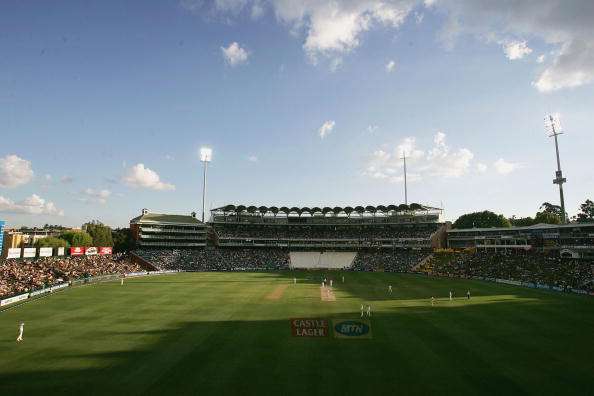Joshua Peck looks at the players and history behind the remarkable story of the Wanderers
So, to the Wanderers – a ground where history is often made and where England will feel they have a chance. Even more so now Vernon Philander has again been ruled out with injury.
England will not look back too fondly on their last Test visit to Johannesburg, though. The home side winning that one by an innings and 74 runs to secure a 1-1 draw in the series six years ago.
It has been more than two years since the ground, known as the ‘Bullring’ because of its often intimidating atmosphere (think Edgbaston at 4.00pm), hosted a Test, though, with South Africa falling just short in their chase of 458 to draw against India.
There is, perhaps, a wonderful sense of irony that South Africa’s last series before the current one came against India, too.
There it was spin that dismantled South Africa, but it is not often that spin plays such a crucial part in the country’s largest city.
Philander was the Proteas’ highest wicket taker in that draw in December 2013, taking seven in the match, but the ankle injury he picked up in the Sub-continent prior to England’s visit has meant he is yet to leave the physio’s room.
He’s on the way back, but Philander was not named in the squad for the final two Tests. How South Africa could do with him.
Without Dale Steyn in Cape Town, the Proteas struggled for wickets. Even on that dramatic final day, James Taylor, Jonny Bairstow and Moeen Ali did enough to thwart the bowlers. With Steyn and Philander fit and firing, it may well have been a different story.

Philander’s projected recovery period of between six and eight weeks came to an end this week, but match fitness would have always been an issue.
Unsurprisngly, he is not featuring in the latest round of domestic matches, which also started yesterday, but he could play in the following week’s fixture which starts on the same day as the
Wanderers Test on January 14. It won’t be enough to put himself into contention for the final Test at Centurion though.
Of course, it is not just Philander who will be missing out on a place in the South Africa XI. JP Duminy was dropped for the second Test, but he is playing in the latest round of first-class matches, as is Rilee Rossouw.
It seems unlikely that either of them will be brought back into consideration in view of the way the batsmen showed their worth in Cape Town, but the selectors will be wanting them to lay down a marker in the domestic scene.
Hardus Viljoen is yet to feature in the Test arena, but he may be retained in the squad, ahead of Chris Morris, who had a forgettable debut with the ball. He impressed with the bat, mind.
The Wanderers is Viljoen’s home ground, and he took 20 wickets in two games there in the first two first-class matches of the season.
The Wanderers certainly has its fair share of history. England actually won the first Test to be played at the ground in 1956, and it has gone on to witness numerous memorable moments.
Following South Africa’s readmission to international cricket, the ground became a lasting memory for many England fans when Mike Atherton batted for more than 10 hours to save the second Test in 1995.
Altitude plays a major part, too. The stadium is 6,000 feet above sea level which creates a unique atmosphere with the air noticeably thinner air at such a height.
It means high scores are common. In 2003 the Bullring hosted the World Cup final when Australia made 359-2 and cruised to victory over India.
Of course, Australia lost one of the most famous matches of all time in Jo’burg as South Africa successfully chased an ODI world-record total of 434-4 in 2006.
And just a year ago there, AB de Villiers broke the 19-year-old record for fastest ODI half-century, previously held by Sri Lanka’s Sanath Jayasuriya, by making 50 off just 16 balls against the West Indies.
In the same innings he went on to break New Zealander Corey Anderson’s fastest ODI century record (set one year and seven days earlier) by making 100 off 31 deliveries.It is not just in cricket, though, that the Bullring – the third Test ground in Johannesburg following the Old Wanderers Stadium and Ellis Park – and its environs has sporting significance.
For more than 70 years, the Illovo district in which the ground is based has been a focal point for Johannesburg sport, be it cricket, golf and, in recent years, football. There is even tennis, squash and bowls tucked away in the surrounding back streets.
In October 2004, however, the Wanderers clubhouse was entirely gutted by a fire, which began in the kitchens and spread through the ventilation ducts, leaving little chance of rescuing three-quarters of a century of tradition.
Among the trophies, photographs and memorabilia lost forever was the bat with which Graeme Pollock scored 274 against Australia in 1966-67, while this ground also witnessed the best Test bowling performance ever by a South African, when Hugh Tayfield took 9-113 in the fourth Test against England in 1956/57.
Temba Bavuma made South African history in Cape Town, and it is perfectly set up for someone else to get their name in the record books.
This piece originally featured in The Cricket Paper, Friday January 8 2016















